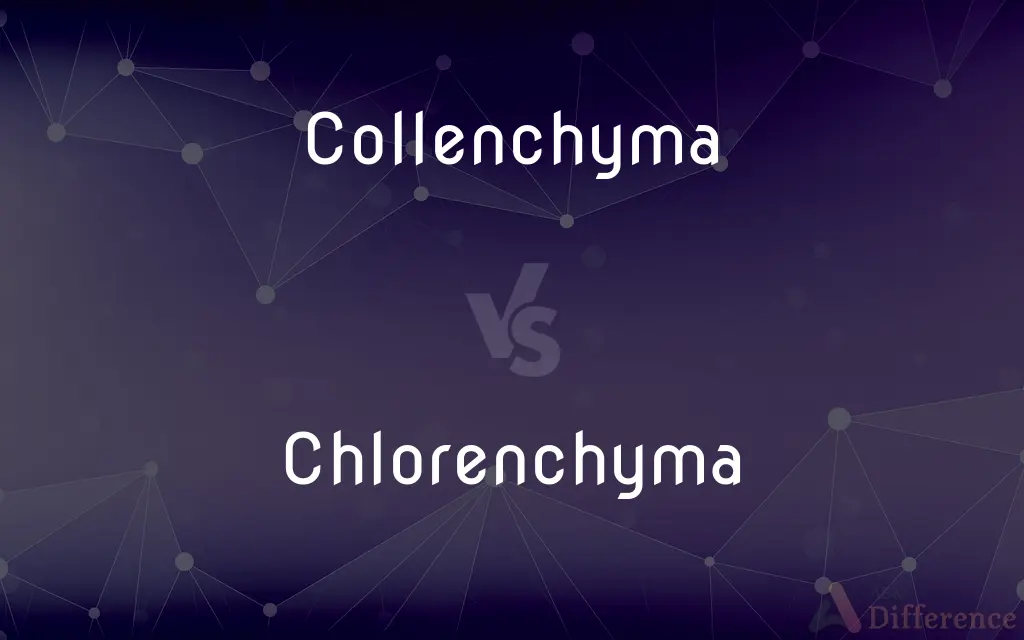Collenchyma vs. Chlorenchyma — What's the Difference?
By Tayyaba Rehman — Updated on September 23, 2023
Collenchyma is a type of plant cell providing support and flexibility, while Chlorenchyma contains chloroplasts and is involved in photosynthesis.

Difference Between Collenchyma and Chlorenchyma
Table of Contents
ADVERTISEMENT
Key Differences
Collenchyma and Chlorenchyma are specialized plant tissues serving unique functions. Collenchyma tissue primarily provides support and elasticity to growing plant parts. This tissue is made of elongated cells, often found under the epidermis. Chlorenchyma, on the other hand, is a tissue that contains chloroplasts and is directly involved in photosynthesis, playing a key role in converting light energy into chemical energy.
Both Collenchyma and Chlorenchyma are crucial for plant growth and development. The strength of stems and flexibility in young plants is attributed to the presence of Collenchyma. Its cells have thickened cell walls that allow bending without breaking. Chlorenchyma, with its chloroplast-rich cells, primarily aids in the production of food for the plant. These cells capture light energy and utilize it to produce glucose.
In terms of distribution, Collenchyma cells are often found in leaf veins and the cortex of stems. They are typically absent in roots. Chlorenchyma cells, being the site of photosynthesis, are usually found in the mesophyll of leaves. Their abundance of chloroplasts makes them vital to the plant's sustenance.
To summarize, while both Collenchyma and Chlorenchyma are essential for plants, they serve distinctive roles. Collenchyma provides mechanical support and flexibility, whereas Chlorenchyma is central to the process of photosynthesis.
Comparison Chart
Primary Function
Support and flexibility
Photosynthesis
ADVERTISEMENT
Cell Characteristics
Elongated cells with thickened cell walls
Cells rich in chloroplasts
Location
Leaf veins, cortex of stems
Mesophyll of leaves
Presence of Chloroplasts
Generally absent
Present
Role in Plant Growth
Provides strength to growing plant parts
Vital for food production in plants
Compare with Definitions
Collenchyma
A plant tissue providing support and flexibility.
The stem's ability to bend without breaking is due to Collenchyma.
Chlorenchyma
A tissue in plants responsible for photosynthesis.
Chlorenchyma cells are abundant in the green parts of plants.
Collenchyma
Essential for mechanical support in young plants.
Young stems remain upright due to the presence of Collenchyma.
Chlorenchyma
Contains chloroplasts essential for converting light energy.
The photosynthetic activity in leaves is majorly carried out by Chlorenchyma.
Collenchyma
Made of elongated cells with unevenly thickened walls.
Collenchyma cells give strength to the young parts of plants.
Chlorenchyma
Central to the plant's energy and food production process.
Without Chlorenchyma, plants wouldn't produce the energy they need.
Collenchyma
Often found beneath the epidermis in stems and leaves.
In many plants, Collenchyma is located just below the surface.
Chlorenchyma
Often green due to the presence of chlorophyll in chloroplasts.
The green coloration of leaves is attributed to Chlorenchyma.
Collenchyma
Lacks vascular tissues and is not involved in transport.
Collenchyma, unlike xylem or phloem, doesn't transport nutrients.
Chlorenchyma
Typically found in the mesophyll region of leaves.
In leaf cross-sections, Chlorenchyma forms the bulk of the tissue.
Collenchyma
A supportive tissue of plants, consisting of elongated living cells with unevenly thickened walls.
Chlorenchyma
Plant tissue consisting of parenchyma cells that contain chloroplasts.
Collenchyma
(biology) A living, elongated, mechanical and flexible ground tissue with angular pectin depositions; present just under leaves, tendrils and stems of climbers; formed before vascular differentiation.
Chlorenchyma
(botany) A mechanical, supportive ground tissue in plants containing chloroplasts.
Collenchyma
A tissue of vegetable cells which are thickend at the angles and (usually) elongated.
Chlorenchyma
Parenchyma whose cells contain chloroplasts
Common Curiosities
What role does Chlorenchyma play in photosynthesis?
It contains chloroplasts that convert light energy into chemical energy.
Where is Chlorenchyma found in plants?
Mainly in the mesophyll of leaves.
Is Chlorenchyma found in stems?
It can be, especially if the stem is green and photosynthetic.
What is the main function of Collenchyma?
Providing support and flexibility to plants.
Is Collenchyma present in roots?
Typically, it is absent in roots.
How does Collenchyma provide flexibility?
It has thickened cell walls allowing bending without breaking.
What is the cellular structure of Collenchyma like?
Elongated cells with unevenly thickened walls.
Why is Chlorenchyma green?
Due to the presence of chlorophyll in chloroplasts.
Do Collenchyma cells have chloroplasts?
Generally, they do not.
Do both Collenchyma and Chlorenchyma participate in photosynthesis?
Only Chlorenchyma is involved in photosynthesis.
Is Collenchyma vascular tissue?
No, it lacks vascular tissues.
What gives Chlorenchyma its green color?
The chlorophyll within its chloroplasts.
Where is Collenchyma typically located?
In leaf veins and the cortex of stems.
Does Chlorenchyma aid in transport within plants?
No, its primary role is photosynthesis.
How are Collenchyma and Chlorenchyma different in function?
Collenchyma provides support, while Chlorenchyma is involved in photosynthesis.
Share Your Discovery

Previous Comparison
Chinese vs. Taiwanese
Next Comparison
Fennel vs. AniseAuthor Spotlight
Written by
Tayyaba RehmanTayyaba Rehman is a distinguished writer, currently serving as a primary contributor to askdifference.com. As a researcher in semantics and etymology, Tayyaba's passion for the complexity of languages and their distinctions has found a perfect home on the platform. Tayyaba delves into the intricacies of language, distinguishing between commonly confused words and phrases, thereby providing clarity for readers worldwide.













































